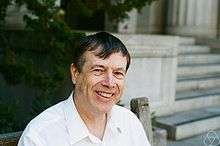Jean Bourgain
| Jean Bourgain | |
|---|---|
 Jean Bourgain | |
| Born |
28 February 1954 Ostend, Belgium |
| Nationality | Belgian |
| Fields | Mathematics |
| Institutions |
Institute for Advanced Study University of Illinois, Urbana-Champaign University of California, Berkeley |
| Alma mater | Vrije Universiteit Brussel |
| Doctoral advisor | Freddy Delbaen |
| Doctoral students | James Colliander |
| Known for |
Analytic number theory Harmonic analysis Ergodic theory Banach spaces Partial differential equations |
| Influences |
Laurent Schwartz Bernard Maurey Gilles Pisier Vitali Milman |
| Influenced | Terence Tao |
| Notable awards |
Salem Prize (1983) Ostrowski Prize (1991) Fields Medal (1994) Shaw Prize (2010) Crafoord Prize (2012) |
Jean Bourgain (born 28 February 1954) is a Belgian mathematician. He has been a faculty member at the University of Illinois, Urbana-Champaign and, from 1985 until 1995, professor at Institut des Hautes Études Scientifiques at Bures-sur-Yvette in France, and since 1994 at the Institute for Advanced Study in Princeton, New Jersey.[1] He is currently an editor for the Annals of Mathematics. From 2012 - 2014, he was appointed a visiting scholar at UC Berkeley.[2]
He received his Ph.D. from the Vrije Universiteit Brussel in 1977.
His work is in various areas of mathematical analysis such as the geometry of Banach spaces, harmonic analysis, analytic number theory, combinatorics, ergodic theory, partial differential equations, spectral theory and recently also in group theory. He has been recognised by a number of awards, most notably the Fields Medal in 1994.
In 2000 Bourgain connected the Kakeya problem to arithmetic combinatorics.[3][4]
In 2009 Bourgain was elected a foreign member of the Royal Swedish Academy of Sciences.[5]
In 2010 he received the Shaw Prize in Mathematics.[6]
In 2012 he and Terence Tao received the Crafoord Prize in Mathematics from the Royal Swedish Academy of Sciences.[7]
References
- ↑ Biography: Jean Bourgain, University of St Andrews, Scotland
- ↑ "Jean Bourgain | Department of Mathematics at University of California Berkeley". math.berkeley.edu. Retrieved 2016-04-23.
- ↑ J. Bourgain, Harmonic analysis and combinatorics: How much may they contribute to each other?, Mathematics: Frontiers and Perspectives, IMU/Amer. Math. Soc., 2000, pp. 13–32.
- ↑ Tao, Terence (March 2001). "From Rotating Needles to Stability of Waves: Emerging Connections between Combinatorics, Analysis and PDE" (PDF). Notices of the AMS. 48 (3): 297–303.
- ↑ Royal Swedish Academy of Sciences: Many new members elected to the Academy, press release on 12 February 2009
- ↑ Shaw Prize Press Release
- ↑ Crafoord Press Release on 19 January 2012
External links
- MathSciNet: "Items authored by Bourgain, Jean."
- O'Connor, John J.; Robertson, Edmund F., "Jean Bourgain", MacTutor History of Mathematics archive, University of St Andrews..